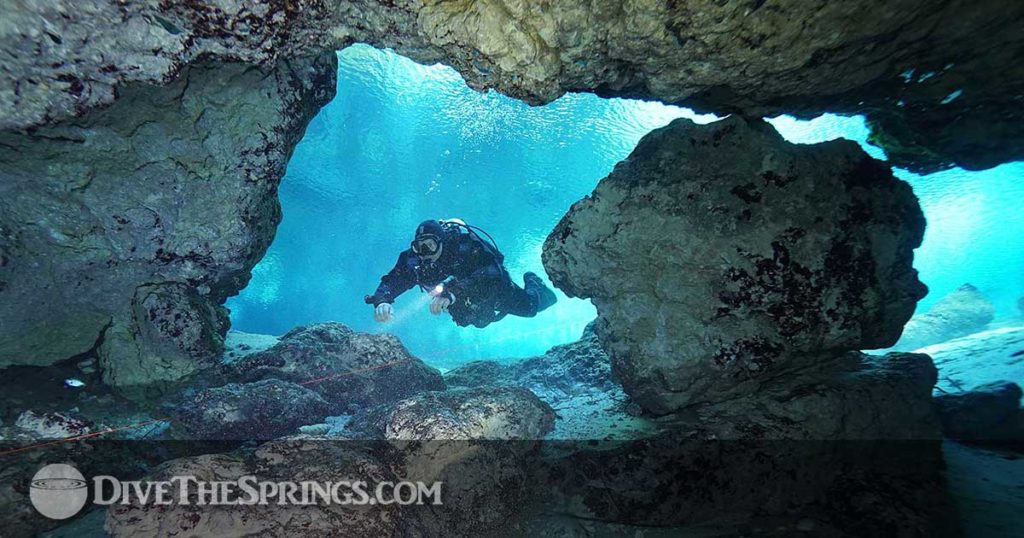Someone recently commented on a Facebook post that, “any time you enter a natural overhead environment, you need a minimum of Cavern Diver certification.” While this is certainly the ideal way to do things and it holds true throughout much of the world, it is not the only choice available to divers in north-central Florida.
There are, in fact, four different ways to cavern dive in the Florida springs with little more risk than you would experience in open water. Just bear in mind these pertain only if you remain within sight of the entrance.
If you lose sight of daylight you are no longer in a cavern but in a cave. This is significantly more dangerous and requires highly specialized training and equipment.
So what are these four ways?
4 Follow the No-Lights Rule
If you don’t take a light with you when entering an underwater cavern, it’s nearly impossible to get into trouble.
- To start, you won’t be going in very far; typically no more than 10 m/30 ft.
- Being that close to the exit and daylight, you will have no difficulty finding your way out.
- Additionally, you will be closer to the surface should you need to make any sort of emergency ascent.
The only problem with the No-Lights Rule is that it runs contrary to human nature. About the only way most divers would voluntarily leave their lights behind is if forced to do so.
The No-Lights Rule is what is in effect at most Florida State Parks. If you don’t have a Cavern or Cave Diver card, you are not allowed to take lights in the water with you.
Unfortunately, enforcement of this rule is very sporadic. Consequently, it may only be a matter of time before we have to bring another body out.
3 Stick to commercially-operated dive sites with proven safety records
In north-central Florida, this pertains to just four sites. These are:
- Ginnie Spring
- Devil’s Den
- Blue Grotto
- Paradise Spring
What do these sites have in common?
- The caverns do not connect to a maze of underwater passageways in which divers could easily become lost.
- To the best of our knowledge, none of these sites have a history of divers wandering into them, becoming lost and then not being able to find their way out in time.
- There is a broad consensus among cave diving instructors that these four sites are the sole exceptions to the rule that you need special training or supervision to cavern dive safely.
It’s important for divers to understand, however, that just because it is okay to dive these four sites without special training and equipment, the same is not true elsewhere.
2 Go with a qualified guide
This is a popular activity in Mexico’s Yucatan Peninsula. Here, Divemasters and Instructors who are fully cave-certified undergo a special training program that qualifies them to conduct guided cenote dives for visiting divers. The caverns used have also been set up to facilitate guided dives.
Although less popular in the USA, it is also possible to have a qualified Cavern or Cave Instructor conduct guided cavern dives in popular springs. This is the only way divers who are not fully certified Cavern or Cave Divers, or students undergoing this training, can take lights with them in state parks.
1 Get Cavern Diver training and certification
This is undoubtedly the best possible solution. As a certified Cavern Diver, you can take lights with you into the caverns at both commercially-operated dive sites and Florida State Parks.
The knowledge and skills you acquire in your Cavern Diver course are also applicable to caverns in other parts of the world. However, the benefits of Cavern Diver training go beyond this.
- To start, you will acquire exceptional buoyancy control skills as well as learn how to maintain a perpetual state of horizontal trim.
- You will learn how to dive with the least weight possible as well as how to modify your gear to reduce the risk of entanglement.
- You will also learn new propulsion techniques designed to minimize the possibility of silting. These same techniques will also reduce the risk of you causing damage to coral and other fragile aquatic life in open water.
Bear in mind, however, that Cavern Diver training is not for beginners. You need a certain amount of knowledge and skill going in. Without this, you are better off sticking with the first three options outlined here.
About the author: Harry Averill is a TDI and NSS-CDS Cave Diver Instructor Evaluator and a past NSS-CDS Training Chairman. Harry authored the TDI Cavern Diver manual and numerous other how-to publicaqtions on cavern and cave diving. He has certified several hundred cavern and cave divers and trained more than a dozen cave diving instructors. So, yes, it’s possible he knows a thing or two about the subject.

